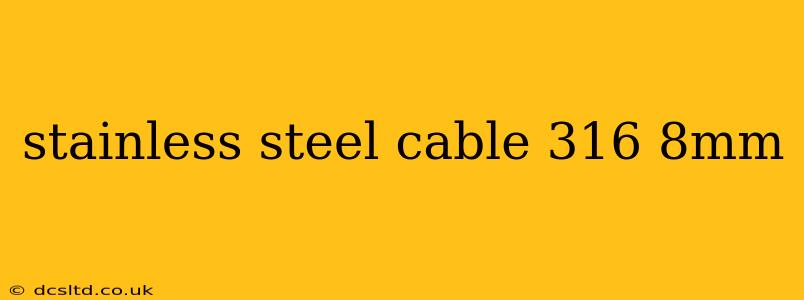Stainless steel cable, specifically grade 316 in an 8mm diameter, is a popular choice for a wide range of applications due to its exceptional strength, corrosion resistance, and durability. This guide will delve into the specifics of 8mm 316 stainless steel cable, exploring its properties, uses, and considerations for selection and maintenance.
What are the properties of 8mm 316 stainless steel cable?
8mm 316 stainless steel cable boasts several key properties that make it highly desirable:
-
High Tensile Strength: Its robust construction provides excellent tensile strength, meaning it can withstand significant pulling forces before breaking. This makes it ideal for applications requiring high load-bearing capacity. The exact tensile strength will vary slightly depending on the manufacturer and the specific construction of the cable (e.g., 7x7, 7x19 construction).
-
Excellent Corrosion Resistance: Grade 316 stainless steel contains molybdenum, which significantly enhances its resistance to corrosion, particularly in marine environments. This makes it suitable for outdoor applications, including marine rigging, coastal structures, and other applications exposed to saltwater or harsh weather conditions.
-
Durability and Longevity: Combined with its corrosion resistance, the inherent strength of 316 stainless steel ensures a long lifespan, reducing the frequency of replacements and lowering long-term costs.
-
Flexibility (relative to other materials): While not as flexible as some other cable types, 8mm 316 stainless steel cable offers sufficient flexibility for many applications. However, it's crucial to consider the required bending radius to avoid damage.
What is 316 stainless steel?
316 stainless steel is an austenitic stainless steel alloy known for its superior corrosion resistance compared to other stainless steel grades like 304. The addition of molybdenum to the alloy composition significantly improves its resistance to pitting and crevice corrosion, making it particularly well-suited for marine and chloride-rich environments. This makes it a premium choice for demanding applications.
What are the common uses of 8mm 316 stainless steel cable?
The versatility of 8mm 316 stainless steel cable leads to its use in a diverse range of applications, including:
-
Marine applications: Mooring lines, sailboat rigging, yacht hardware, and other nautical equipment.
-
Industrial applications: Lifting and hoisting, suspension systems, and general engineering purposes where high strength and corrosion resistance are vital.
-
Construction: Suspension systems for bridges, architectural features, and other structural elements.
-
Outdoor applications: Fencing, railings, and other outdoor installations needing protection from the elements.
Where can I buy 8mm 316 stainless steel cable?
8mm 316 stainless steel cable can be purchased from various industrial suppliers, marine equipment stores, and online retailers specializing in metal products. It's important to choose a reputable supplier to ensure the quality and consistency of the cable. Always verify certifications and specifications before purchasing.
What are the safety considerations when using 8mm 316 stainless steel cable?
Safety is paramount when working with any type of cable, especially high-strength materials like 8mm 316 stainless steel. Here are some key safety considerations:
-
Proper handling and storage: Avoid sharp bends or kinks, which can weaken the cable. Store it in a dry place to prevent corrosion.
-
Regular inspection: Regularly inspect the cable for signs of wear, damage, or corrosion before each use. Replace any damaged cable immediately.
-
Appropriate fittings: Use only high-quality fittings designed specifically for 8mm 316 stainless steel cable. Improper fittings can lead to cable failure.
-
Safe working load limits: Never exceed the cable's safe working load limit (SWL). This information is usually provided by the manufacturer and should be strictly adhered to.
How do I maintain 8mm 316 stainless steel cable?
Regular maintenance is crucial to prolong the life and safety of your 8mm 316 stainless steel cable:
-
Regular visual inspection: Check for signs of wear, corrosion, or damage.
-
Cleaning: Clean the cable regularly with mild soap and water to remove dirt and debris. For marine applications, rinsing with freshwater is essential after saltwater exposure.
-
Lubrication (where applicable): Depending on the application, lubrication may be beneficial to reduce friction and wear. Consult the manufacturer's recommendations.
-
Storage: Store the cable correctly when not in use to prevent damage and corrosion.
This comprehensive guide should equip you with a thorough understanding of 8mm 316 stainless steel cable. Remember to always prioritize safety and follow best practices for handling, maintenance, and application.
